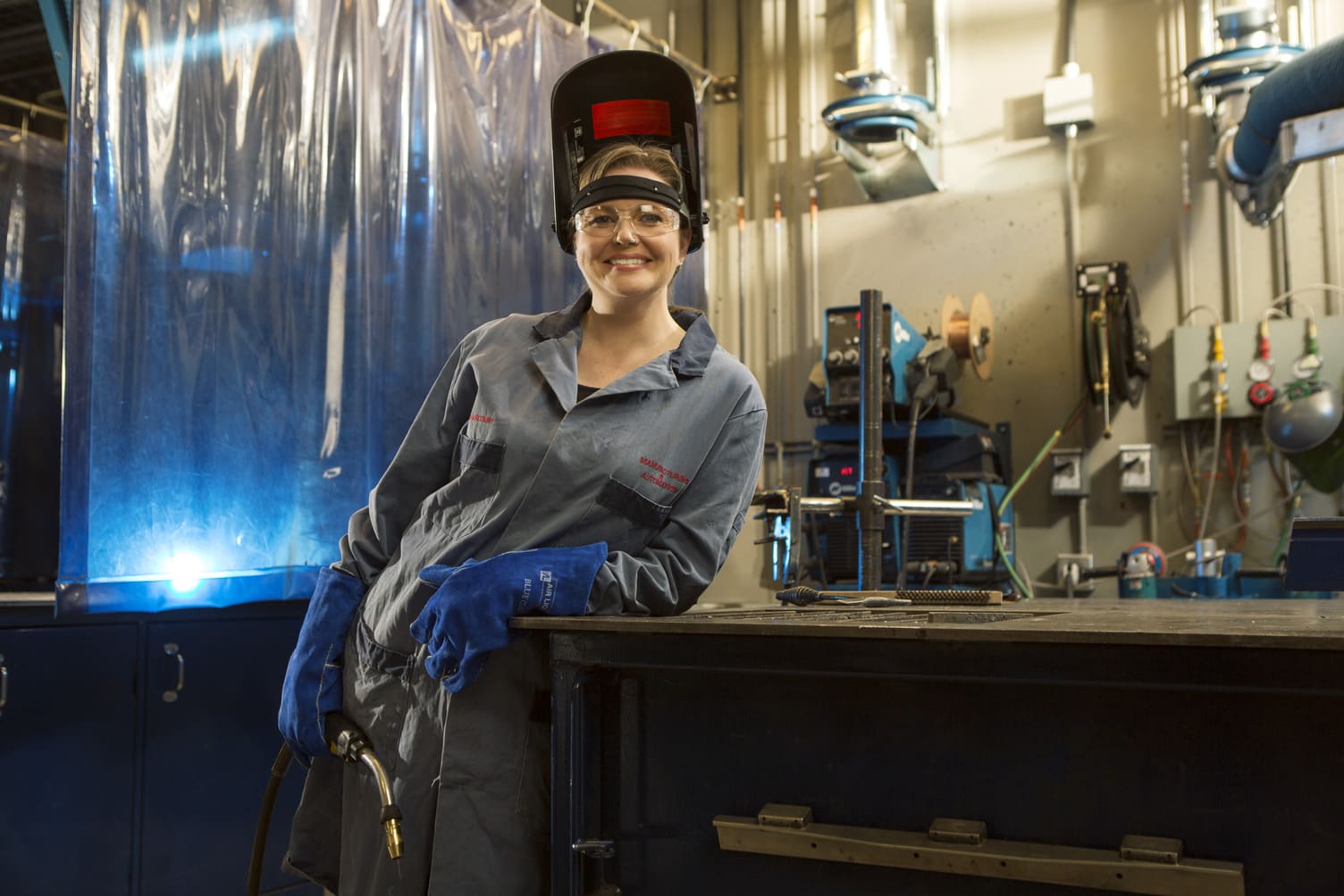On this page:
Overview
Learn to manage and dispense parts inventories, handle stock, and identify and catalogue parts and assemblies in various industries like automotive, heavy-duty, farm implement, industrial, recreational vehicles, plumbing, electrical and more.
There are two specializations for this trade:
- Parts technician: you’ll sell supplies and parts, order parts, keep inventories, receive supplies, catalogue parts, organize returns, maintain records, submit bills, prepare statements and receive payments. These duties depend on the size of the wholesale, retail or warehouse distribution business and the types of parts involved.
- Materials technician: you’ll prepare and ship orders, process returns, complete inventory processes in place, interact with customers, handle products, operate equipment and calculate transportation costs.
Parts and materials technicians are skilled tradespeople who are self-motivated and enjoy working with people. This line of work is most fulfilling for those who enjoy business practices.
To succeed in this trade, you should:
- have good physical strength, manual dexterity and stamina
- be organized and analytical
- be capable of working independently
- have math, communication and computer skills
- get along well with customers and fellow workers.
Upon successfully completing the required working hours and technical training periods, you'll be awarded a certificate in addition to journeyperson status by Alberta’s Apprenticeship and Industry Training.
This is a Red Seal Endorsed trade — a recognizable standard that allows tradespeople to work across Canada.
Careers and opportunities
Our graduates may work in the following occupations. Some careers require additional experience and education.
Associated National Occupational Classification (NOC) codes: 12102, 13201, 14401, 14403, 60020, 62100, 64101, 75101.
Apprenticeship training
For each specialization, apprentices will spend three periods of apprenticeship education and on-the-job training before becoming a journeyperson.
SAIT delivers training periods for this trade in the Weekly Apprenticeship Training System (WATS). This means you'll spend a single day each week in an online classroom for each training period.
The term of apprenticeship for a parts technician is three years (three 12-month periods) including a minimum of 1500 hours of on-the-job training each year.
Year 1 | Period 1
You'll learn about workplace safety and environment protection. You'll also cover material handling, material storage, material identification, calculations and communications.
Training length: 32 weeks
Year 2 | Period 2
You'll learn about engines and related systems, power train, hydraulics, steering, suspension, air brakes, electrical, auto body, agriculture and mobile industrial equipment.
Training length: 37 weeks
Year 3 | Period 3
You'll learn about inventory, procurement, design and planning, business management, human relations and industry network.
Training length: 32 weeks
The term of apprenticeship for a material technician is three years (three 12-month periods), including a minimum of 1500 hours of on-the-job training and six weeks of apprenticeship education each year.
Year 1 | Period 1
You'll learn about standard workplace safety and environmental protection regulations, material handling and storage, material identification and calculations and effective communication practices.
Training length: 32 weeks
Year 2 | Period 2
You'll learn about logistics, facility management, transportation and traffic, material identification, tool cribs and leadership.
Training length: 37 weeks
Year 3 | Period 3
You'll learn about inventory, procurement, design and planning, business management, human relations and industry network.
Training length: 32 weeks
Apprenticeship education performance
You must pass each section of the course and the AIT exam to succeed in apprenticeship education.
The passing grade for each period is no less than 50% in each course, with no less than a 65% average overall. A passing mark on each provincial exam and the interprovincial qualification (Red Seal Exam) is 70%.
View Alberta's Apprenticeship and Industry Training procedures
Training pathways
You can earn your journeyperson designation in one of the following ways.
The traditional training pathway begins with finding a job with an employer willing to indenture you as an apprentice. Once you are an apprentice, you will alternate between on-the-job training and educational periods.
You must apply for an apprenticeship through Alberta Apprenticeship and Industry Training before attending your first education period at SAIT.Admission requirements
To enter an apprenticeship, you must have the educational qualifications required or recommended education for the trade to which you apply.
Entrance requirements are monitored and set by Alberta Apprenticeship and Industry Training.
Minimum requirements
Successful completion of the following courses:
- English 10-2
- Math 10-3
OR
A pass mark in all five Canadian General Educational Development (GED) tests
OR
Alberta Apprenticeship and Industry Training entrance exam.
Recommended requirements
Apprentices with an Alberta High School Diploma that includes the following courses:
- English 30-2
- Math 30-3
- Physics 20 or Chemistry 20 or Science 20
- Related career and technology studies (CTS) courses

MyTradeSecrets
Once you have begun working as an apprentice, you can attend SAIT to complete your technical training.
You'll register for technical training at SAIT on MyTradeSecrets or you can register by phone.
Transfer agreements
At SAIT, we have created transfer agreements with partner institutions to allow you to earn course credits toward your SAIT program based on your previously completed credentials.
Transfer Alberta search tool
Use the Transfer Alberta search tool to see all transfer agreements between Alberta post-secondary institutions (including those with the University of Calgary, Mount Royal University and Bow Valley College.)
Search transfer agreements in Alberta
There are no formal transfer agreements currently in place for this program.
Transfer options for graduates
When you have completed this program, you may continue your education at a partner post-secondary institution. These transfer agreements include partnerships within and/or outside of Canada.
Credits this program transfers to
- Available credits:
- 42
- Available credits:
- 45
Available intakes
Costs
2025/26 tuition and fees
The following costs are effective as of July 1, 2025.
Parts Technician
Materials Technician
This is a bring-your-own-device program with a standard computer hardware and software requirement. See the specific requirements on our computers and laptops page.
Books or modules, along with other items for classes, are approximately $600 per period.
We recommend you don't purchase books or modules ahead of time as they might be outdated by the time you attend classes, and they cannot be returned to the Bookstore.
Personal protective equipment (PPE) will be required for the program, which may be an additional cost to apprentices.

Funding options for apprentices
Apprentices get to learn while they earn, but there are still costs to consider. Many resources are available at SAIT and federally to help support apprentices.
Information sessions
Prepare for a strong start in your chosen program or get the details you need to decide your future path.
Our expert staff and faculty are ready to answer your questions and provide information about the following:
- What sets SAIT apart
- An introduction to the program and area of study
- Admission requirements
- Future career paths
- Information on the earning potential and graduate employment rates.
Contact
Have more questions?
Apprenticeship training and registration
Apprenticeship and Industry Training Client Services

Oki, Âba wathtech, Danit'ada, Tawnshi, Hello.
SAIT is located on the traditional territories of the Niitsitapi (Blackfoot) and the people of Treaty 7 which includes the Siksika, the Piikani, the Kainai, the Tsuut’ina and the Îyârhe Nakoda of Bearspaw, Chiniki and Goodstoney.
We are situated in an area the Blackfoot tribes traditionally called Moh’kinsstis, where the Bow River meets the Elbow River. We now call it the city of Calgary, which is also home to the Métis Nation of Alberta.
